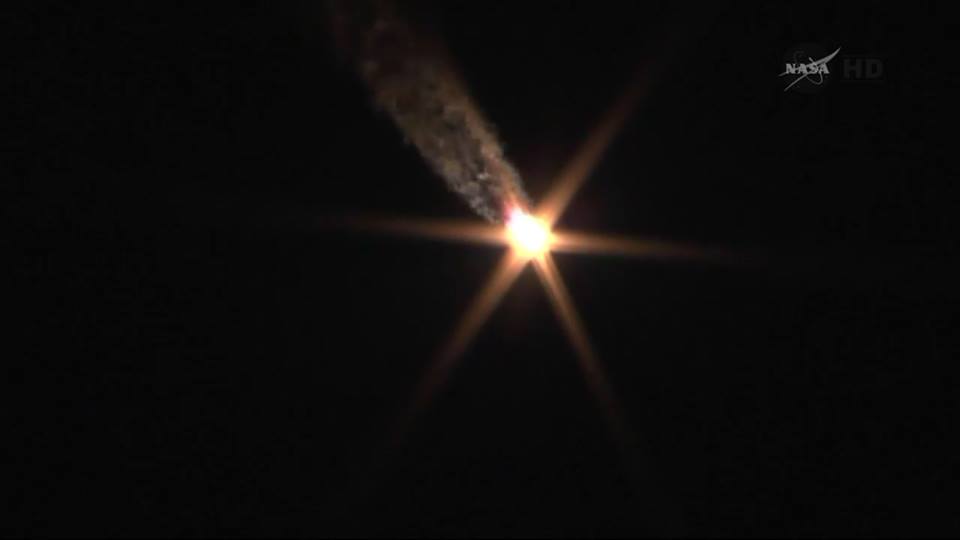
The second half of Expedition 39 is on its way to the International Space Station (ISS), following tonight’s rousing launch of Soyuz TMA-12M and its crew of Russian cosmonauts Aleksandr Skvortsov and Oleg Artemyev and U.S. astronaut Steve Swanson. Liftoff occurred precisely on time from the Baikonur Cosmodrome in Kazakhstan at 3:17 a.m. local time Wednesday, 26 March (5:17 p.m. EDT Tuesday, 25 March), and within nine minutes the three spacefarers had safely reached orbit. They will now execute a series of computer-controlled thruster firings to effect a rendezvous and docking with the ISS about six hours, and four orbits, into their mission. Docking at the station’s space-facing (or “zenith”) Poisk module is currently expected at 11:05 p.m. EDT Tuesday, and the crew will enter the orbital outpost about two hours later.
Skvortsov, Artemyev, and Swanson will spend almost six months aboard the ISS, firstly as the second half of Expedition 39—under the command of Japanese astronaut Koichi Wakata—and from mid-May onward as the core of Expedition 40. As noted in AmericaSpace’s Soyuz TMA-12M preview article, this is a highly talented crew. Swanson is making his third space voyage, having previously served as a mission specialist on the STS-117 and STS-119 shuttle flights in June 2007 and March 2009. He is also the only EVA-experienced member of the Soyuz TMA-12M crew, having performed four spacewalks during his two shuttle flights. Skvortsov is making his second space mission, having flown for 176 days in April-September 2010, serving as a flight engineer aboard Expedition 23 and as commander of Expedition 24. Artemyev is making his first space mission.
The three men and their backups—Russian cosmonauts Aleksandr Samokutyayev and Yelena Serova and U.S. astronaut Barry Wilmore, who are currently expected to rotate into the prime crew slot for Soyuz TMA-14M in September—traveled from the Star City training center, on the forested outskirts of Moscow, to desolate Baikonur on 13 March for final preparations, simulations, and fitting of their custom-made “Sokol” (“Falcon”) launch and entry suits and molded Soyuz seat liners. Last week, the Soyuz TMA-12M spacecraft was checked and installed atop its rocket, and on Sunday, 23 March, the stack was rolled horizontally to the launch pad and tilted to the vertical. Yesterday (Monday), as the State Commission declared the flight readiness of both the prime and backup crews, a Russian Orthodox priest at the launch pad performed the traditional blessing of the vehicle and the mission upon which it would soon embark.
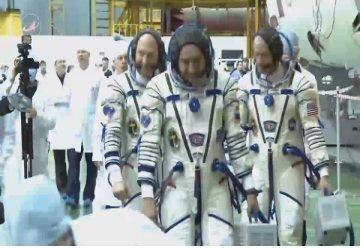
Launch Day was expected to last about 22 hours for Skvortsov, Artemyev, and Swanson. According to Spaceflight101, the crew was awakened at 6:47 p.m. local time (8:47 a.m. EDT) Tuesday, about 8.5 hours before launch, and after showering and enjoying their final breakfast in terrestrial gravity for the next six months, they traditionally signed their hotel room doors and received an Orthodox blessing. After departing the Cosmonaut Hotel by bus, they were transported to Site 254 at Baikonur, where they underwent final medical checks and began donning their Sokol suits at about 10:50 p.m. local time (12:50 p.m. EDT). With visors closed and the suits fully pressurized, technicians verified that the three Sokols were ready for launch. The backup crew of Samokutyayev, Serova, and Wilmore were on hand for assistance. The crew were also granted the opportunity for a final, face-to-face (albeit behind glass) conversation with their families and close friends during this period.
By 11:20 p.m. local time (1:20 p.m. EDT) Tuesday, with four hours remaining until liftoff, the liquid oxygen tanks aboard the rocket were declared full and a “topping” stage was initiated, ensuring that cryogenic boil-off was continuously replenished until shortly before launch. Skvortsov, Artemyev, and Swanson departed Site 254 by bus and arrived at the base of the launch pad at 12:30 a.m. local time Wednesday (2:30 p.m. EDT Tuesday). About 30 minutes later, the process of boarding the elevator and climbing into their seats aboard the bell-shaped Soyuz TMA-12M descent module got underway. By 1:50 a.m. local time Wednesday (3:50 p.m. EDT Tuesday), the three men were strapped into their seats—with Skvortsov in the center commander’s position, flanked by Artemyev to his left and Swanson to his right—and the Soyuz hatch was closed. A green and yellow toy duck (nicknamed “Quack”) hung in the cabin, provided to the crew as a gift from Skvortsov’s daughter, and served as an indicator of the onset of microgravity.
Ninety minutes remained before launch, during which time an exhaustive series of pressure and other spacecraft checks were performed. By 2:30 a.m. local time Wednesday (4:30 p.m. EDT Tuesday), the launch pad had been cleared of all personnel and the guidance system was activated and flight software was uploaded to the computers. Shortly afterward, the clamshell-like servicing gantry was pulled away from the rocket and was fully retracted by 2:40 a.m. local time Wednesday (4:40 p.m. EDT Tuesday). The escape system was enabled. During this quiet time, music was piped into the Soyuz cabin by launch controllers, with NASA commentator Josh Byerly explaining that astronauts’ and cosmonauts’ past choices varied widely from traditional Russian and Kazakh songs to ZZ Top and Bon Jovi.
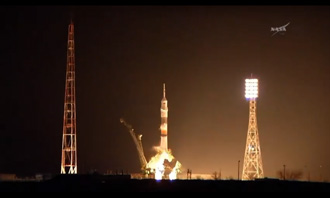
According to AmericaSpace’s Launch Tracker, it was a beautiful, though very cold, night at Baikonur. “With temperatures around freezing point and clear skies, there is no problem with weather causing a problem for the flight,” noted the Tracker. “Indeed, there should be some great views of the ascent on the way to the ISS.” Josh Byerly pointed to temperatures of about 4 degrees Celsius (40 degrees Fahrenheit). In the final minutes, Skvortsov’s controls were activated and the three men were instructed to close their visors. Internal avionics were initiated and the on-board flight recorders spooled up to monitor the myriad systems. Inside the control bunker at Baikonur, the “launch key” (“a real, actual key,” according to Byerly) was inserted at T-5 minutes, effectively enabling the ordnance to support Soyuz TMA-12M’s ascent, and the final phase of the countdown included the completion of nitrogen purging, the pressurization of propellant tanks, and the topping-off of cryogenics.
At T-10 seconds, the turbopumps on the rocket’s central core and its four tapering strap-on boosters awoke and the engines steadily built up thrust to full power, producing a retraction of the fueling tower and a liftoff at 3:17 a.m. local time Wednesday (5:17 p.m. EDT Tuesday).
Rising rapidly, the vehicle passed 1,100 mph (1,770 km/h) within a minute of liftoff, and at T+118 seconds, at an altitude of 28 miles (45 km), the four strap-on boosters exhausted their propellant and were jettisoned. This left the central core and its single RD-108 engine to continue the push toward orbit. By two minutes into the flight, the vehicle was traveling at more than 3,350 mph (5,390 km/h). The payload shroud and escape tower were jettisoned shortly afterward, and, some 4 minutes and 58 seconds after leaving Baikonur, the core stage separated at an altitude of 105 miles (170 km) and the third and final stage roared to life to boost Skvortsov, Artemyev, and Swanson to a velocity in excess of 13,420 mph (21,600 km/h). By the time the third stage departed the vehicle, nine minutes into the flight, the crew was in space. “Weightlessness confirmed!” it was reported, as Quack the Duck began floating for the first time in microgravity. The ascent had been flawless, with “Nominal” repeated a number of times and several assurances that the crew was feeling “Great.”
In the following minutes, Josh Byerly speculated that Expedition 39 crewmen Koichi Wakata, Mikhail Tyurin, and Rick Mastracchio had overflown Baikonur shortly before liftoff and, owing to the night-time launch, they may have had the chance to see part of the ascent from their perch aboard the ISS.
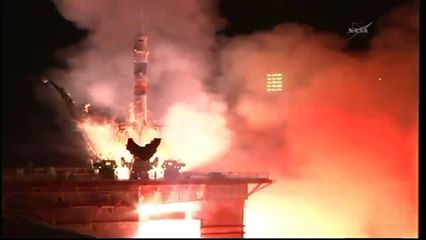
As with the last four crewed ISS missions, Soyuz TMA-12M will follow a “fast rendezvous” profile to reach the space station a mere six hours, and four orbits, after liftoff. Shortly after orbital insertion, the spacecraft’s antennas and twin electricity-generating solar arrays were successfully deployed. Two computer-guided thruster “burns” are scheduled to occur within the first 90-minute orbit of Earth, with several others to follow over the next couple of hours. According to NASA, the spacecraft will dock with the station’s space-facing (or “zenith”) Poisk mini-research module at 11:05 p.m. EDT Tuesday, about five hours and 48 minutes after departing Baikonur. In the aftermath of capture, a complex series of pressure and other checks will be conducted to verify the integrity of the seal between the two space vehicles. Hatch opening is anticipated at 12:45 a.m. EDT Wednesday, almost two hours after docking, and Skvortsov, Artemyev, and Swanson will undoubtedly be engulfed in hugs from the incumbent Expedition 39 crew.
Wakata, Tyurin, and Mastracchio have been in orbit since early November 2013 and will remain aloft until mid-May. Two weeks ago, with the departure of Expedition 38, Wakata became the first Japanese to command the ISS. With the arrival of Skvortsov, Artemyev, and Swanson, Expedition 39 will increase to six members. Wakata and Swanson flew together in March 2009—the former as Japan’s first long-duration ISS resident, the latter as a mission specialist on STS-119. “Koichi is a fantastic person,” admitted Swanson. “He always got the term The Man from his earlier missions, because he was so good at everything.”
However, there will be little time for the newcomers to adapt to their surroundings, for on 30 March SpaceX will launch the third dedicated Dragon cargo mission (SpX-3) under its $1.6 billion Commercial Resupply Services (CRS) contract with NASA. It is scheduled to be berthed, via the 57.7-foot (17.6-meter) Canadarm2 robotic arm, onto the Earth-facing (or “nadir”) port of the Harmony node on 2 April. It will remain in place for about a month. A few days later, on 7 April, Russia’s Progress M-22M cargo ship will depart the ISS and shortly be replaced by the fresh Progress M-23M. Later in April, the Progress M-21M cargo ship—which has been docked at the station since November 2013—will undock for two days of tests of its Kurs-NA (“Course”) rendezvous and navigation systems. After redocking on 25 April, Progress M-21M will remain at the ISS until mid-June.
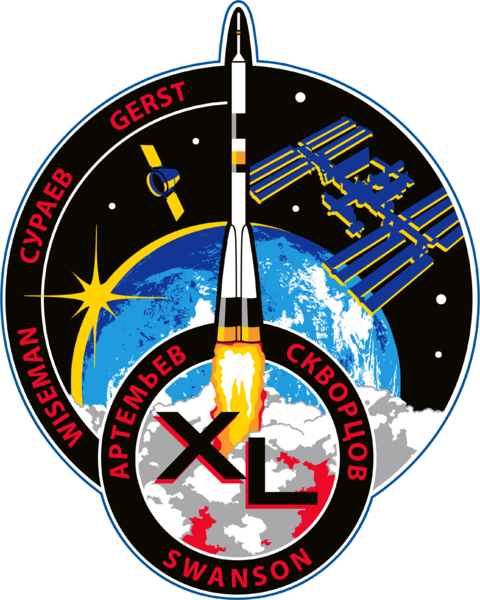
Three major events will occur in May. The first is the expected launch of Orbital Sciences Corp.’s second dedicated Cygnus cargo mission (ORB-2), under its $1.9 billion CRS contract with NASA, on the 6th. By now, the Harmony nadir location will have been vacated by SpX-3 and the Expedition 39 crew will again employ Canadarm2 to grapple Cygnus to berth it at the station for about five weeks. The second event is the planned return to Earth of Soyuz TMA-11M crewmen Wakata, Tyurin, and Mastracchio on 14 May, completing a mission of 188 days. Shortly before their departure, Wakata will formally hand command of the ISS over to Steve Swanson, who will take the helm of the new Expedition 40.
Two weeks later, on 28 May, Soyuz TMA-13M will launch with its crew of Russian cosmonaut Maksim Surayev, NASA astronaut Reid Wiseman, and Germany’s Alexander Gerst—the latter of whom is participating in the European Space Agency’s (ESA) “Blue Dot” mission—to bring Expedition 40 up to its full, six-man strength. The month of June is expected to feature the undocking and departure of both Progress M-21M and the ORB-2 Cygnus mission, with July highlighted by the expectation of two U.S. EVAs. According to NASASpaceflight.com, U.S. EVA-26 will involve Swanson and Wiseman and will take place on or around 10 July, with Wiseman and Gerst performing EVA-27 a week later on 17 July. Cosmonauts Skvortsov and Artemyev will perform Russian EVA-38 in August. Although Swanson is a veteran of four previous spacewalks—having racked up a cumulative 26 hours and 22 minutes in two excursions on each of his STS-117 and STS-119 shuttle missions, back in June 2007 and March 2009 respectively—Wiseman, Gerst, Skvortsov, and Artemyev have yet to savor the experience of EVA.
Russian cargo ships will perform a changeout in July, as Progress M-23M departs and Progress M-24M arrives a few days later, with ESA’s fifth and final Automated Transfer Vehicle (ATV)-5 also planned for launch on 25 July. Named in honor of the Belgian astronomer Georges Lemaître, ATV-5 will be boosted aloft by an Ariane 5 vehicle, whose “cryotechnic main stage” arrived at the Guiana Space Centre on Thursday, 20 March, for pre-launch processing. August is expected to see SpaceX’s fourth Dragon mission (SpX-4), and Expedition 40 will conclude on 11 September with the return of Skvortsov, Artemyev, and Swanson aboard Soyuz TMA-12M, touching down in Kazakhstan, after a voyage lasting approximately 170 days. In leaving the ISS, Swanson will hand command of the space station over to Surayev, who will lead Expedition 41.
Want to keep up-to-date with all things space? Be sure to “Like” AmericaSpace on Facebook and follow us on Twitter: @AmericaSpace
Missions » ISS » Soyuz TMA-M » TMA-12M »



